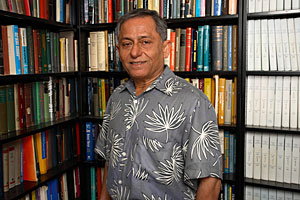Fazle Hussain, Hugh Roy & Lillie Cranz Cullen Distinguished Professor of Mechanical Engineering, has been elected as an officer of the National Academy of Engineering’s Mechanical Engineering Section.
His three-year term, which begins on July 1, includes one-year terms as secretary and then vice-chair and will culminate with Hussain serving as chair of the Mechanical Engineering Section, one of the most prestigious positions in the mechanical engineering community.
As a member of the executive committee, he will play a key role in setting policy for the section on issues facing mechanical engineers on the national and international levels and represent and promote the interests of the Mechanical Engineering community (consisting of experts from business, academia and government) at the NAE.
According to its website, the “NAE provides engineering leadership in service to the nation.” Under the congressional act signed in 1863 by President Abraham Lincoln, the NAE is directed “whenever called upon by any department or agency of the government, to investigate, examine, experiment, and report upon any subject of science or art.”
“National policy must be set on many important issues, such as energy, the environment, pollution, health, transportation, manufacturing, innovation and defense. The National Academy’s role is to advise the United States Congress and executive branch on these matters, analyze the pros and cons of different options and evaluate/suggest optimal strategies and solutions,” said Hussain.
In addition, he said, “There is intense competition not only among the many sub-disciplines of mechanical engineering, but also between mechanical engineering and other branches of engineering and related fields—traditional and modern—for the very limited number of new members inducted into NAE each year. There is a need to balance a candidate’s originality, creativity, depth and breadth of life-long experience, vision on the national and international levels, and ability to forcefully and objectively articulate critical views. So the ME section has to do its homework to identify the most qualified nominees in the country, as well as internationally, each year, prune the number typically by more than 90%, and present the finalists to NAE. Traditional fields like ME are always under the threat of losing their share of new inductees to newer fields like bioengineering, IT, and materials.”
This election is yet another honor in Hussain’s highly distinguished career. A fluid dynamicist who specializes in vortex dynamics and turbulence, much of his research has focused on the search for order within disorder in fluid turbulence. He has published more than 250 scientific papers on this and related topics, about 70 of which have been well cited, according to the Science Citation Index.
These and other accomplishments have made Hussain arguably the most decorated fluid dynamicist ever. Of the field’s four most coveted awards, only two other people have won two. Hussain has won all four, including:
- The Freeman Scholar Award from the American Society of Mechanical Engineers, or ASME (1984)
- The Fluid Dynamics Prize from the American Physical Society (1998)
- The Fluids Engineering Award from the ASME (2000)
- The Fluid Dynamics Award from the American Institute of Aeronautics and Astronautics (2002).
In addition, Hussain has received several honors from his native country, Bangladesh. He is one of the few members of the Bangladesh Academy of Science; the first recipient of the Bangladesh Society of Mechanical Engineers’ Gold Medal (2003); and was decorated with the country’s Institution of Engineers’ Bangladesh Medal, presented to him by the Bangladeshi prime minister in 2004.
Hussain’s election to the NAE Mechanical Engineering section however is only one of his recent accomplishments. He also recently received a three-year, $300,000 grant to conduct research that may result in reduced delays at airports.
The grant, awarded by the National Science Foundation, will fund Hussain’s research into aircrafts' trailing vortices, which are swirling flow behind an airplane caused by the difference in air pressure above and below the plane’s wings.
These vortices form at the tips of the wings and can remain energetic for large enough distances behind a plane to present dangers to other airplanes that encounter them. All such vortices naturally transition into turbulence due to small perturbations, or disturbances, that disrupt the orderly circular flow of air. The turbulent trailing vortex then decays relatively quickly, making it safe for additional aircraft to pass through the area once occupied by a vortex.
This entire process can take minutes, however, consuming valuable time on airport runways both for takeoffs and landings. Multiplied over several arrivals and departures, these waits can contribute to long flight delays, especially at busier airports. When these delays become a big enough problem at an airport, the typical solution is to build a new runway. This can be costly though, since the average runway costs more than $2 billion to build, largely due to the land-acquisition costs, said Hussain.
To avoid these costs while still easing congestion, Hussain will attempt to cause trailing vortices to transition into turbulence more quickly than they do naturally, thus encouraging their decay and making runways usable more quickly. All this, he theorizes, can be accomplished though the creation of near-axis swirl.
Initially using computer modeling, Hussain will test the effects of adding a small spinning device to the tip of an aircraft’s wings. This device will cause a rotation of air that will introduce perturbations into a vortex. By introducing perturbations instead of waiting for them to occur naturally, the entire vortex-to-decayed-turbulence process will be shortened.
“Our goal,” said Hussain, “is to show that (speeding the transition to turbulence) is achievable, as well as why and how it is possible.”
